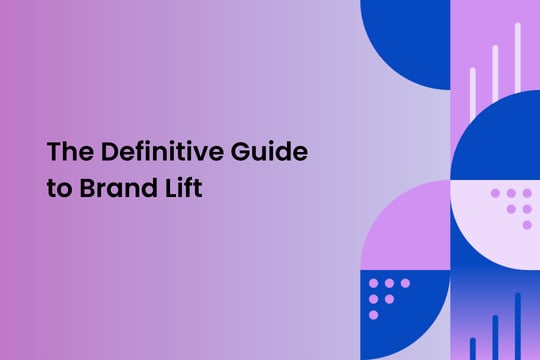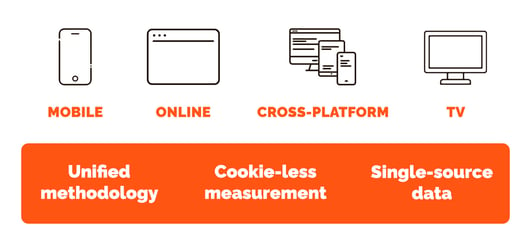The definitive guide to Brand Lift

Brand lift study data provides a tool for brands and agencies to optimize the ROI on their advertising
Brand lift measurement helps brands and agencies understand the effectiveness of their advertising, leading to improved targeting, campaign optimization, and creative development.
By measuring the impact of advertising on consumer awareness and perceptions, brand lift data provides a key tool for brands and agencies to optimize the return on their advertising investments.
What is brand lift? A brand lift study or brand lift survey shows how exposure to advertising changes people’s awareness and perceptions of a brand when compared to people who were not exposed to the brand’s advertising.
What you will learn:
- What is brand lift or attitudinal lift measurement?
- How do you know who has seen an ad?
- How do you know the impact of the ad?
- How is brand lift different from brand tracking?
- How does brand lift compare to outcomes lift?
- What does brand lift tell us about the success of an ad?
- How can I use brand lift in my organization?
- How does DISQO approach brand lift?
What is brand or attitudinal lift measurement?
Brand or attitudinal lift measurement focuses on quantifying how people’s attitudes toward a brand change after being exposed to an advertisement. Typically a brand lift study will explore how exposure to an ad changes:
- Brand awareness - do people remember the brand?
- Ad awareness - do people remember the ad?
- Message association - do people associate the messages with the brand?
- Brand familiarity - how well known is the brand?
- Brand favorability - how is the brand perceived?
- Brand preference - is the brand preferred vs. others?
- Brand consideration - is the brand thought of in the category?
- Purchase intent - do people intend to buy the brand?
How do you know who has seen an ad?
Understanding which consumers have been exposed to an advertisement is fundamental to the measurement of advertising effectiveness. It is also a task that has become increasingly complicated in the face of concerns about consumer privacy and the waning utility of third-party cookies. In digital advertising, ad servers distribute ads to online publishers to display on the sites and platforms. These ads can carry a tracking cookie which allows a measurement provider to see who has been exposed to the ad. However, these tracking cookies from measurement firms and tech vendors do not capture everyone who has been exposed to an ad because:
- Some browsers block the acceptance of cookies by default,
- Some people chose to block the acceptance of cookies, and
- Some publishers do not allow tracking cookies on their sites.
The difficulty of using cookies or mobile IDs to track advertising has increased with concerns about consumer privacy, how such data is being used, and who is collecting the data. Without complete measurement of who has seen an ad, brand lift becomes difficult to assess.
In some cases, publishers and media platforms can see who has been exposed to their ads on their own sites and platforms. This can be helpful in understanding who was exposed on one site, but people visit many sites and the complete measurement of ad exposure is a critical step in producing dependable brand lift data.
An alternative approach to knowing who has been exposed to an ad is to offer consumers the opportunity to install apps on their computer or phone which measure whether that person has been exposed to the ad. In order for consumers to install apps such as this, they must be provided information about who is collecting this data, and what the app does, as well as be given value in exchange for allowing this measurement.
Choosing a measurement solution built on 100% consented opt-in brand measurement directly from consumers’ own devices eliminates the issues with cookies and delivers a better user experience. This approach also allows brands to measure the impacts of advertising across all platforms, including difficult-to-measure social media platforms, with a single source of data and a unified methodology.
Brand Lift can also measure ad impact from TV ads, including CTV/OTT and Linear advertising. This is done by matching individuals who have been exposed to the ad through passive TV datasets and/or by asking people about their TV viewing habits to see if they were watching TV when the ad ran. The latter option is called opportunity to see (OTS) measurement and it can also be used to measure exposure in other media such as newspapers, magazines, and even outdoor billboards.
How do you know the impact of the ad?
Establishing a proper accounting of people who have been exposed to an ad lays the groundwork for exploring the impact created by an advertising campaign. Not everyone who sees an advertisement is impacted by the ad and some consumer activities, such as purchasing a brand’s product, would have happened with or without exposure to an ad.
INCREMENTALITY: The impact of an ad over what would have happened without exposure to the ad is called incremental lift or incrementality .
To properly assess the impact of an ad, two samples of the consumer population are created:
- A test group of consumers who were exposed to the advertising campaign, and
- A control group of consumers who were not exposed to the advertising campaign.
Comparing the behaviors of these two groups makes it possible to understand how exposure to an ad campaign impacted behavior. In order for this comparison to be accurate, it is important that both the exposed and unexposed groups share similar characteristics, such as their demographic attributes and their digital behaviors.
How is brand lift different from brand tracking?
Brand lift studies focus on measuring the impact of a particular advertising campaign and results are evaluated based on specific goals that are established prior to the launch of the campaign. In contrast, brand tracking studies, also referred to as brand equity studies, track top line attitudes about a brand over a period of time that will likely span multiple advertising campaigns. Brand Lift studies run concurrently with brand tracking studies.
How does brand lift compare to outcomes lift?
Brand lift and outcomes lift are both sets of metrics that describe the impact of exposure to an advertisement on consumers. While brand lift focuses on measuring how exposure to an ad impacts consumer attitudes and opinions of a brand, outcomes lift focuses on measuring an ad’s impact on the online behavior of consumers exposed to an ad campaign.
Used together they can create a powerful and comprehensive assessment of advertising impact and effectiveness. Brand lift measurement helps a brand understand whether or not its ad campaign is delivering the desired messages to consumers and having a positive impact on the way a brand is perceived.
Outcomes lift measurement helps brands understand what kind of consumer behaviors are driven by their advertising.
What does brand lift tell us about the success of an ad?
Brand lift studies provide a range of actionable intelligence across multiple dimensions of ad impact from brand and ad awareness to brand favorability to intent to purchase. This intelligence helps marketers optimize their advertising by delivering insight about:
- Whether the ad delivered the intended message and resonated with consumers,
- The impact different creative treatments had on ad performance,
- How well the ad performed with different demographic groups, and
- How different advertising channels or ad placements impact ad performance.
By looking at brand lift across these different dimensions, brands can make data-driven decisions about how to shape, target, and place their advertisements for optimal impact.
How can I use brand lift in my organization?
The results of a brand lift study can be used in a variety of ways by different members of a marketing organization as they work together to deliver the highest possible impact for an advertising campaign.
The creative team can use data about the impact of different creative treatments and messages to optimize their strategy. Those responsible for media buying can use brand lift results to select the platforms and media partners which will deliver the highest impact.
Operations teams responsible for executing campaigns can use brand lift data to do in-flight optimization. For those responsible for brand data and analytics, brand lift data provides valuable information about how to best use first-party data to target for success. 
How does DISQO approach brand lift?
With DISQO’s Brand Lift, marketers can rely on a single source of data and a unified methodology to measure how their advertising changes consumer sentiment and preferences. By using fully consented data from the DISQO audience, brands are able to measure campaigns across all platforms, including siloed social media networks, mobile devices, and CTV.
When used in conjunction with DISQO Outcomes Lift, marketers can finally understand how their advertising impacts the entire consumer journey, affecting not just consumer attitudes and preferences, but also their actual behaviors.

Subscribe now!
Get our new reports, case studies, podcasts, articles and events

